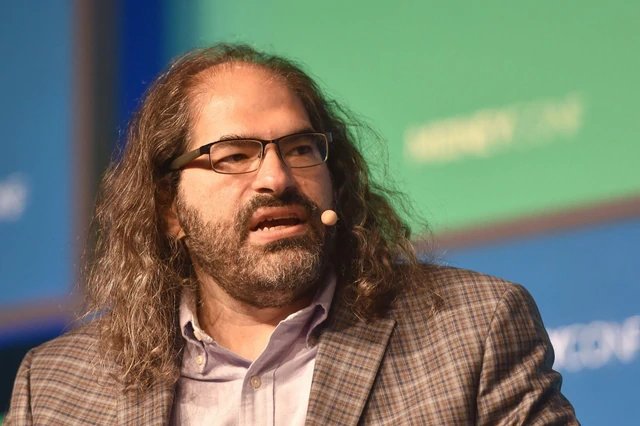David Schwartz

David Schwartz

David Schwartz, CTO of Ripple, is interviewed by Fortune's Jeff Roberts
Education
In 1990, David graduated from the University of Houston.[1][4] The following year he was awarded his first patent for a distributed computer network he designed to lighten the burden of a central processor.[4]
Career

David Schwartz pictured with Brad Garlinghouse, CEO at Ripple

The Ripple Story: CTO David Schwartz on the Founding, Ledger & XRP
From 1991-1992, Schwartz worked as a software developer at RE/MAX, where he conceived and developed a system to analyze public property records and identify houses that were the most likely to be over-assessed and entitled to property tax reductions. In 1992, along with his father, David became the co-founder of Cardiophonics, a medical device manufacturing company that developed, manufactured, and sold a non-invasive medical device to provide objective measurements of the presence and severity of heart murmurs and related conditions.[1][4]
After leaving the company in 1995, he became the Director of Network Services.
He planned and managed a regional service provider network and helped bring the first Integrated Services Digital Network service to South Florida. From 1996-1998, he was a Senior Network Engineer at Worldwide Internet Solutions, where he supervised the design, implementation, and deployment of a regional network and a large document scan, index, search, and retrieval system. Schwartz also managed the development of the disaster recovery, monitoring, and billing systems.[1][6]
Schwartz developed encrypted cloud storage and enterprise messaging systems for organizations like CNN and the National Security Agency.[3] Along the way, Schwartz developed an online persona, JoelKatz (the name was inspired by Stimpson J. Cat from Ren & Stimpy: Stimpy's Invention), to pseudonymously publish his philosophical meanderings. His widely-read JoelKatz blog is subtitled “Democracy is vulnerable to a 51% attack,” an allusion to the tipping point at which one party could gain majority control of a cryptocurrency, no longer making it decentralized. @JoelKatz, his Twitter handle, has more than 159,000 followers.[4]
Ripple
Around 2011, Schwartz met Jed McCaleb, the founder of the Mt. Gox Bitcoin exchange and an early Napster competitor called eDonkey2000. They met at a coffee shop, where McCaleb shared an idea he had called NewCoin. By the end of the conversation, the two had decided to see if they could build a financial infrastructure similar to Bitcoin that would use less energy and reduce transaction time. Schwartz, who started working on the code that would eventually underpin the XRP cryptocurrency, said in an interview with Forbes:
“My objective initially was just to see if it was true.
And then, probably a month and a half later, we reached the point where I proved to him that yes, this would work, it would be possible, but we didn’t know what it would be good for.
It was like inventing a new material.
Is it really light?
Is it really strong?
Is it manufacturable?
Is it durable?
Does it rust?
And then, once you have all those properties, is there some use case for that?”[4]
McCaleb and Schwartz joined forces and soon brought on another programmer, Arthur Britto, to help Schwartz finish XRP's technical architecture.
In 2012, while Schwartz and Britto wrote code, veteran tech executive Chris Larsen, who previously worked at Prosper Loans, joined Ripple as its first chief executive. Larsen quickly set out to recruit hundreds of global banks to test early versions of Ripple’s technology. In 2014, McCaleb became disgruntled and departed, “forking,” or copying, XRP’s code to start rival venture Stellar.[4]
Schwartz went on to help build two financial tools that would become Ripple’s first core products: xVia, a payment interface designed to let users send payments globally with increased transparency, and xCurrent, an enterprise software that lets banks initiate and settle transactions.
By moving the transactions to a shared, distributed ledger that only permissioned users can access, Ripple claimed to be able to facilitate transactions in as little as a few seconds instead of days.
As a result, in 2015 Ripple formed the RippleNet Committee, an advisory team made up of major banks including Bank of America Merrill Lynch, Japan’s MUFG Union Bank, Standard Chartered, Westpac, and Spain’s Banco Santander, which invested in Ripple and began experimenting with early versions of its payment technology.[4]
Banks’ interest in Ripple coincided with the general excitement bubbling up around bitcoin in 2016 and 2017.
Despite the fact that none of Ripple’s early banking partners were using XRP cryptocurrency, its penny stock price, coupled with confusion over its actual relationship to Ripple, caused XRP to soar on crypto exchanges to a peak of $3.65 in January 2018, up from $.006 only a year before.
This gave the untested currency a market value of $140 billion.
Larsen, who received 9 billion XRP tokens as its CEO, saw his crypto holdings rise to as much as $60 billion.
Schwartz, in his turn, opted for a salary and a 2% stake in Ripple, instead of the XRP cryptocurrency he helped create.
To this day Schwartz is not listed as a co-founder of Ripple, despite being its chief architect.[4]
Investments
In November 2020, Schwartz revealed he has lost more than $300,000 investing in altcoins.
According to a November 2 post on Quora asking readers if they had lost any money trading Bitcoin and other cryptocurrencies, Schwartz stated that he had made a few crypto investments that he “ultimately had to write off as worthless.” “I’ve bought quite a few cryptocurrencies that turned out to be disasters,” stated Schwartz, who is a frequent Quora contributor.
“My total losses, just on tokens that became completely worthless, is just over $300,000.”[11]
Schwartz listed 11 tokens in particular that turned out to be bad investments for him, including Blocktix (TIX), DICE, Flash (FLASH), Vezt (VEZT), Amp (AMP), Signal Token (SIG), Bee (BEE), Kind Ads Token (KIND), Pryze (PRYZ), KudosCoin (Kudos), and Neuron (NRN). Many of the altcoins went to zero in 2017 and 2018.[11]
Schwartz also revealed in October 2020, that he sold 40,000 Ether (ETH) in 2012.
He also said that he sold an unspecified number of Bitcoin (BTC) for $750 and XRP at $0.10.[11]





